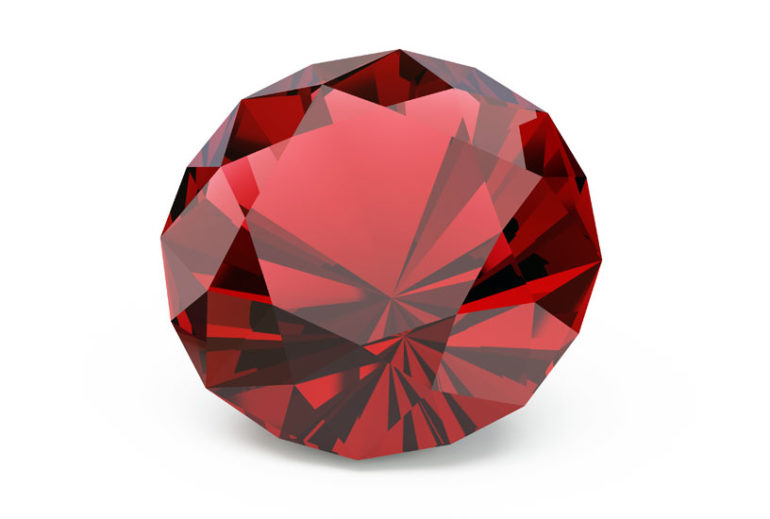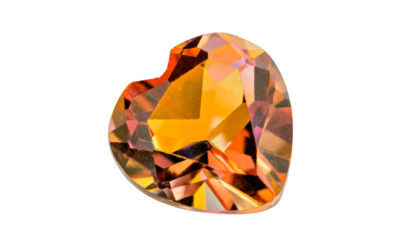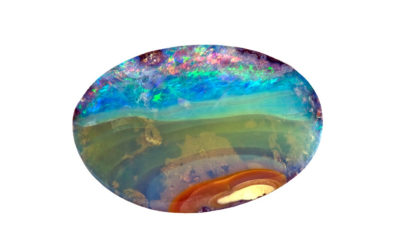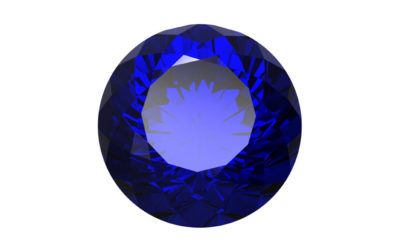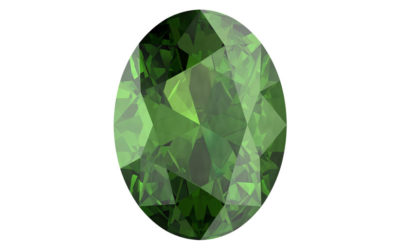Back in 1939, Dorothy in The Wizard of Oz was trying to find her way home. She clicked her heels three times and repeatedly said the now iconic line, “There’s no place like home …” The power to return home, she was told, was with her the whole time, captured in her deep red ruby slippers. They became one of the signature costume bits for the classic movie. You can’t think of The Wizard of Oz without the rubies playing a role.
Rubies have a deeper history than that of The Wizard of Oz and movie history in general. As the birthstone of the month of July, it stands on a par with its precious stone sibling, the diamond, as one of the most popular and sought-after gems of all time.
The origin and color of the ruby
The gem gets its fiery red color from the mineral corundum, which is colored by the element chromium. Color plays a big role in this gem because other colors of the gem-quality corundum are known as sapphires.
The word “ruby” stems from the term “rubeus,” which is a Latin word meaning “red.” It’s also been related to the Sanskrit word “ratnaraj,” which means “king of precious stones.” This is a fitting term for the gem given how long and intricate its history with multiple civilizations is. Its staying power, culturally speaking, has remained unchanged.
The red color of the chromium for which rubies are popular for also gives the gem a fluorescent element to it. This is why, when you hold up the gem, it seems to have a magical fire flickering within. On the not-so-awesome side to this, it is also the reason why the gem is so scarce. The chromium causes it to fissure and crack easily.
Rubies, for all their lasting beauty, hardly ever grow large enough to crystallize. Crystallization is important because this is how you make high-quality gems for jewelry. This scarcity is what makes the gem at times more expensive than a diamond!
The fairest ruby of them all
The best-looking ruby was created by Burma’s Mogok Valley. It was praised for its blend of darkish red with a tint of purple in it. Called Pigeon’s Blood Rubies, these Burmese gems cost higher than the orange-tinted and brown-tinted variants (Pigeon Blood Ruby).
Rubies are heat treated
It wasn’t until the 1990s that it was discovered that rubies could be heat treated. It happened in the Mong Hsu region of Myanmar. This process helped to improve color saturation. Deposits of the other types of the gem can be found in parts of the United States, East Africa, parts of the Middle East, India, Thailand, and Vietnam.
How hard is the ruby?
The July gem measure at a nine on the Mohs scale. This makes it one of the most durable and tough gems out there. The only one that is naturally harder is the diamond.
Believe it or not, the gem isn’t just great for jewelry. Due to its red glow and hardness, it’s also used in making products such as lasers, medical instruments, and watches. In many cases, to cut down on, synthetic rubies are used over the natural ones.
What does the ruby represent?
The depth of the gem’s red coloring has reminded people of the force in life and the vitality of blood. It acts as a magnifying glass of sorts. It brings out the best qualities of vitality, making you more aware, giving you more energy, pumping blood harder in your veins to make you more courageous, increasing the odds of success in combat, romance, and gaining money.
The gem has been used to celebrate wedding anniversaries. Although it doesn’t have a known specific number to an anniversary, the gift of a ruby would be great for twofold reasons – you’re a July baby and it’s your anniversary.
The gem has been popular for centuries now. To add to their symbolism of life and vitality, they’re also believed to heighten your senses, increase your sense of wisdom, and circulate positive energy into your livelihood.
How much is it worth when measured?
The quality of the gem is measured by its carats weight, clarity, cut, and color. The most valuable and brightest shade of red is a pigeon blood ruby. It makes up a majority of the market for the July birthstone.
The deepest red color we know of the stones is rare. Many of them actually have a hue that’s closer to that of a grapefruit. Where it sits currently, the Sunrise Ruby is considered the most expensive one on the market.
As perfect and polished as we see the rubies are on display, they’re actually imperfect in their natural habitat. They have color impurities and inclusions, which are used by gemologists to tell the difference between a natural gem and a synthetic gem. It helps to differentiate between that of substitutes.
In many cases, the rough stone is heated prior to being cut. Nowadays, most of them are heat treated in one way or another. This makes non-treated versions of the gem quite high in price.
How are they cut?
The gem is cut in two distinct ways, a three-point star, and a six-point star. They’re cut into cabochons in order to enhance the effect of color radiance. These little star incisions in the gem are best seen as the light moves while it’s rotated. Inclusions of minerals and slender foreign material fibers in the gem tend to make it pricier. In some rare cases, a color-change happens, which gives it a “cat’s eye effect” (Cat’s Eye Effect).
Not all rubies are red!
Gemology generally calls all corundum that’s dyed a shade of red or pink a ruby. However, the United States has a minimum color saturation requirement the stone must meet in order to be considered a ruby.
If the hue is too light, it’s considered a pink sapphire. This distinction only recently started in the 20th century. There’s still a lot of debate that happened between the ruby vs pink sapphire. Because of this subjective nature, there has been an adoption of a broader definition of the gemstone.
If you wanted a good ruby, once upon a time you went to the Mogok Valley in Upper Myanmar. For centuries, it produced the best gems. But now, good versions have been found in other areas. Another part of Myanmar, the area of Ming Hsu was found to make good rubies too in the 90s.
Where can you find rubies?
Other places it has been mined for famously are in Thailand, the Samlout and Palin districts of Cambodia, Australia, Afghanistan, Colombia, Brazil, India, Namibia, Scotland, and Japan.
After the travesty of World War II, there were deposits of the July birthstone found in Vietnam, Tanzania, Tajikistan, Nepal, and Pakistan. Sri Lanka is where you’ll find the pink shade gem. You’ll have to go to the Republic of Macedonia if you want to find naturally occurring rubies. That is arguably why Macedonia’s 2014 proposal for a new coat of arms consists of the gem.
How rubies are treated – part one
It is common for the gem to be treated in order to improve its quality. It was in the late 90s when a bigger cache of lower-priced materials created a big surge in the supply of treated versions of the gem. This led to lowered prices of the gem.
Included in these improvements are altering color, dissolving the rutile inclusions that affect transparency, healing the cracks inside the gem, and even at times, filling in the gaps completely.
The way in which most gems are treated though is through heat. Many of them are treated with heat to help bring out the red, to take out the purple hue, the “silk,” and the blue patches. The treatment can be as hot as 1800 degrees Celsius (Ruby Quality Factors).
Some rubies are treated with a process of low tube heat. The stone is heated over charcoal with a temperature roughly around 1800 degrees Celsius for twenty minutes to a half an hour. The silk within the gem is broken and then the color pops.
How rubies are treated – part two
Lead glass filling is another form of treatment that’s become popular in recent years. This is the process of filling the cracks within the gem with lead glass. This is also done with a similar material. It helps to improve the transparency of the gem, which can make previously unusable gems ready to be put into jewelry. It’s a four-step process.
The once tougher stones are polished prior to the eradication of all surface impurities. This is in order to keep them from messing up the process. The rough surface is cleaned with hydrogen fluoride. No fillers are added within the first process of heating.
The process takes away the impurities that are deep within the cracks. The process can be completed at temperatures reaching 1400 degree Celsius, but it’s usually done within 900 degrees Celsius.
How rubies are treated – part three
The electric oven that contains different chemical additives does the second process of heating. The solution that’s used has been mixed in different ways and has been shown to work, though the most popular ingredient currently used is lead contained glass powder.
The gem is dipped into a concoction of oils and covered in a powdery substance. It’s then embedded in a tile and put in the oven and heated for an hour to about 900 degrees Celsius. The powder changes colors – from orange to yellow – and it begins to fill in the cracks of the gem. It becomes transparent at the end of the process and helps to improve the gem’s overall transparency.
Natural vs. synthetic rubies
Like other gems, the ruby has a synthetic counterpart. The first one created was in 1837 made by Gaudin. It was done by fusing potash alum with a bit of chromium to give color in high temperature (How to Identify).
But it was in 1903 when Verneuil revealed to others that he had the ability to create synthetic rubies on a commercial scale. He did so by the flame fusion process. From there, his lab grew. In 1910, he had 30 furnaces in his facility. He was producing about two thousand pounds of the gemstone.
Another process for which synthetic rubies were created was through a pulling process done by Czochralski, the hydrothermal process, and the flux process. Flame-fusion is still the most common due to the low cost.
Under a microscope is where you’ll find the imperfections of a synthetic ruby. To the naked eye, it seems smooth and perfect. But under a microscope, you’ll find that some of them will have gas bubbles, curves, and striae.
Perfect rubies are constantly under suspicion of being synthetic. To help distinguish the synthetics from naturals, the dopant is added and reveals what the gem really is.
Synthetic rubies are important
As mentioned before, rubies, especially synthetic ones, tend to have uses beyond that of jewelry making. Synthetic versions of the gem in the form of a rod are used to make lasers and masers.
The first laser was created by Theodore H. Maiman. He used a light-pumped solid-state synthetic ruby to make red laser light that had a wavelength of 694 nanometers. The ruby types of lasers are still used today. The gem is also used in applications where a high hardness is needed. (Theodore H. Maiman)
—
The July gemstone represents emotion, passion, courage, and love according to some cultures. It’s been considered the king of the gemstones for centuries.
Believing to give the wearer good fortune, it makes for a great gift for any July baby. The vitality of the blood-colored stone brings about a sense of pride. It will be their prized possession just like it was for kings and emperors from civilizations past.
You can also surprise them with the pink variety, which will undoubtedly turn heads and create the same debate that gemologist have had if the lighter ones truly are rubies or not.
References
Minerals. “Cat’s Eye Effect – Minerals.net Glossary of Terms” Minerals.net, www.minerals.net/mineral_glossary/cat’s_eye_effect.aspx (accessed October 30, 2018)
Jewelry Notes. “How to Identify a Lab-Created Ruby ‹ Jewelry Notes” JewelryNotes.com, www.jewelrynotes.com/how-to-detect-a-lab-created-ruby/ (accessed October 30, 2018)
Israel Diamonds. “Pigeon Blood Ruby: Discover the beauty and power of vivid rubies” Israel-Diamonds.com, www.israel-diamonds.com/education/gemstone/pigeonbloodruby/default.aspx (accessed October 30, 2018)
GIA. “Ruby Quality Factors” GIA.edu, www.gia.edu/ruby-quality-factor (accessed October 30, 2018)
Encyclopaedia Britannica. “Theodore H. Maiman | American physicist | Britannica.com” Britannica.com, www.britannica.com/biography/Theodore-Maiman (accessed October 30, 2018)

